Dear Family, Friends, and Colleagues,
With daylight savings here and spring just around the corner, we’re excited for the longer days ahead! Get ready for fresh beginnings and all the exciting updates we’ve got in store for you.
Exciting New Opportunities Following our Manhattan Medical Immersion College Cohort!
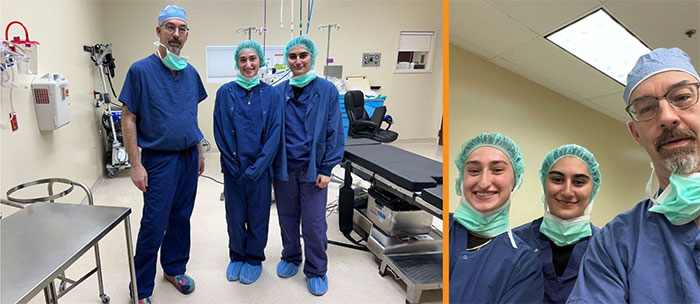
Two of our Manhattan Medical Immersion College Cohort participants, Alisa and Mareba, had the unique opportunity to further develop their medical knowledge. They were invited to observe our experienced Lab Manager, Chris Rish, for an immersive day in the OR. They stepped into a real-world environment, where they shadowed several surgical procedures.
We’re incredibly happy and grateful to offer students experiences that go beyond our Medical Immersion programs!
Intern Spotlight: Achievements and Highlights
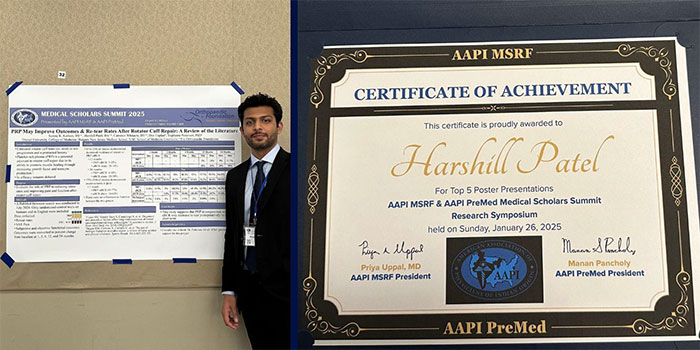
Congratulations to one of our summer research interns, Harshill Patel, for winning the top 5 poster presentation award at the American Association of Physicians of Indian Origin (AAPI) Medical Students, Residents & Fellows Section & AAPI PreMed Medical Scholars Summit Research Symposium on January 26, 2025. Harshall showcased his work entitled PRP May Improve Outcomes & Re-Tear Rates After Rotator Cuff Repair: A Review of the Literature.
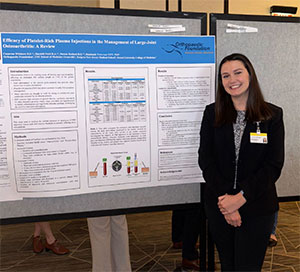
On Wednesday, February 12, Cameron Whitacre, another of our 2024 summer research interns, presented a research poster highlighting her summer work at the University of Carolina School of Medicine Greenville 6th Annual Student Research Symposium entitled Efficacy of Platelet-Rich Plasma Injections in the Management of Large-Joint Osteoarthritis: A Review.
Research Director, Dr. Stephanie Petterson, was also nominated for the mentor of the year award.
Cameron Whitacre’s Innovative Research Presentation
Summer 2025 High School & College Camp Applications Are Open!
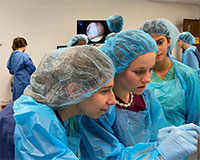 2025 Manhattan Medical Immersion High School Camp
2025 Manhattan Medical Immersion High School Camp
📍 NYC BioSkills Lab
📅 June 29-July 5, 2025
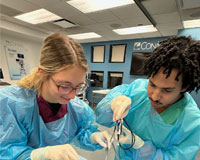 2025 Manhattan Medical Immersion College Cohort
2025 Manhattan Medical Immersion College Cohort
📍 NYC BioSkills Lab
📅 August 15-19, 2025
 Thin Bones on Thin Ice
Thin Bones on Thin Ice
Courtesy of Columbia Surgery & Dr. Ethel Siris
Slipping on ice is a disaster for lots of people because as we age, we lose bone. And when you lose bone, two things happen. One is that as you get older and older, you have less bone and the bone gets thinner. You can’t see this, but if you actually could take a microscope and look at the bone, you’d realize there was less bone there. In addition, the architecture of that bone is altered when it’s aggressively being lost. As a consequence, there’s less quantity of bone and a poorer quality of bone. This makes the bone less strong, so that if you slip on the ice and go down hard, you’re much more likely to break the bone than would have been the case 20 or 30 years earlier.
What can be done to prevent a disastrous fall?
First, you have to make sure that there is nothing else going on in you that might be contributing to your bones. You simply don’t want to be calcium deficient or vitamin D deficient. The second part of what you have to do is very simple: Don’t Fall. Now, what does that mean? “Don’t fall,” nobody wants to fall. But there are two elements to “Don’t fall.” The first is that you should be as physically fit as you’re able to be, through exercise. When you’re in your 50s, 60s, 70s, 80s, and 90s, you’re not going to build bone with exercise, that’s not what it’s for. What you are doing is making yourself more physically fit so that if you slip, you may be able to right yourself and not go crashing down onto the ground. The second element of not falling is more elusive, but it’s very important. And that is paying attention and being mindful of the environment you’re walking in.
Steak with Farro Salad & Grilled Green Beans
Courtesy of Good Housekeeping
 Ingredients
Ingredients
8.8-oz. pkg. of farro, 1 1/2 lb. skirt steak, 12 oz. green beans, 6 tbsp sun-dried tomato pesto, 1/2 cup basil leaves, 1/2 tbsp olive oil, salt and pepper to taste
Bonus: Protein helps with bone density. Protein is a building block for bones and muscles, and it helps the body absorb calcium!
Instructions
1. Cook farro per package directions. Drain and transfer to large bowl.
2. Meanwhile, heat grill or grill pan to medium-high. Season skirt steak (cut crosswise into 4-in. pieces) with kosher salt and pepper. Grill skirt steak to desired doneness, 2 to 4 min. per side for medium-rare, depending on thickness. Transfer to cutting board and let rest at least 5 min. before slicing.
3. In large bowl, toss trimmed green beans with olive oil and salt and pepper. Grill beans along with steak until charred and just tender, 2 to 4 min.
4. Stir in sun-dried tomato pesto, chopped basil leaves, and salt with farro. Serve farro with green beans and steak. Enjoy this protein-packed recipe!
Hey Doc
How do you see Artificial Intelligence in relation to the future of orthopaedics?
Artificial Intelligence (AI) is poised to significantly impact the field of orthopaedics, enhancing patient care, improving surgical outcomes, and transforming clinical practice. These changes will likely affect not only the patient but also the provider. These changes could come from diagnosis, to treatment plans, surgical assistance and even rehabilitation. Regarding diagnosis and imaging, AI algorithms with machine learning models are already being used to assist in interpreting medical images such as X-rays, MRIs, and CT scans. From these findings, treatment plans can be secured for the patient. As we gain more data and data integration, AI can aggregate patient data from various sources (e.g., medical records, imaging, genetic data, physical assessments) to develop personalized treatment plans. Risk prediction for complications will likely be able to be assessed earlier. For surgeons, robotic surgery and real time decision support can lead to better outcomes for patients. Outcomes will be assessed with wearable technologies after surgeries or injuries. AI-powered virtual rehabilitation programs can offer patients interactive recovery exercises, personalized based on their progress. For physician training and education, simulation based, and AI assisted training and learning will also be implemented.
As with any new technologies, challenges and considerations must be vetted. A concern will be data privacy and security. With the increased use of AI, safeguarding patient data will become a major concern. Medical institutions and AI developers will need to ensure compliance with regulations like HIPAA and GDPR to protect patient privacy. Ethical concerns with AI in orthopaedics raise questions about the role of human practitioners. While AI can aid in decision-making, it’s important to ensure that human judgment remains central during patient care. Regarding integration of AI, it must be effective, it needs to be seamlessly integrated into existing clinical workflows and electronic health records, which may require significant changes to how healthcare systems operate.
The future of orthopaedics is likely to be heavily influenced by AI, making procedures safer, more efficient, and more personalized. By combining AI’s data processing capabilities with human expertise, orthopaedic care will likely become more proactive, precise, and patient-centered. However, its successful integration will require careful attention to ethical, security, and regulatory concerns to ensure the technology benefits both patients and healthcare providers.
Many thanks to Shariff K. Bishai, DO, MS, for this Newsletter’s segment of “Hey Doc!” Shariff completed his Fellowship with us in 2007 and currently specializes in shoulder and sports medicine at Detroit Orthopaedic Institute in Troy, MI.
We hope you enjoyed this Newsletter, and we thank you for your continued generous support. Stay active and healthy!
Best wishes,
Janine Bahar
Executive Director
Ph: (203) 869-2002
Web: www.ofals.org
